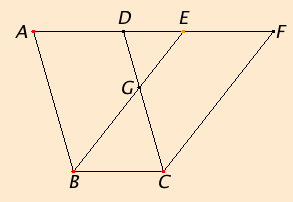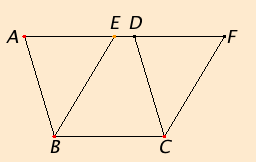Proposition 35
Let ABCD and EBCF be parallelograms on the same base BC and in the same parallels AF and BC.
I say that ABCD equals the parallelogram EBCF.

Since ABCD is a parallelogram, therefore AD equals BC.
For the same reason EF equals BC, so that AD also equals EF. And DE is common, therefore the whole AE equals the whole DF.
But AB also equals DC. Therefore the two sides EA and AB equal the two sides FD and DC respectively, and the angle FDC equals the angle EAB, the exterior equals the interior. Therefore the base EB equals the base FC, and the triangle EAB equals the triangle FDC.
Subtract DGE from each. Then the trapezium ABGD which remains equals the trapezium EGCF which remains.
Add the triangle GBC to each. Then the whole parallelogram ABCD equals the whole parallelogram EBCF.
Therefore parallelograms which are on the same base and in the same parallels equal one another.
